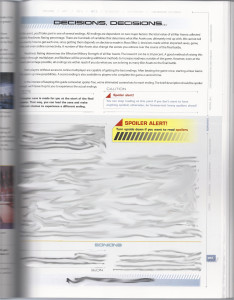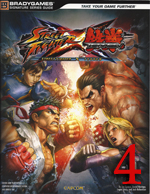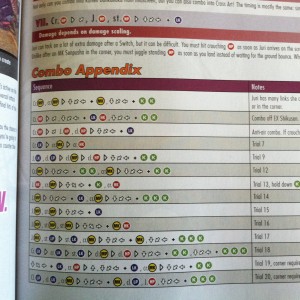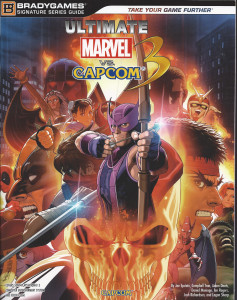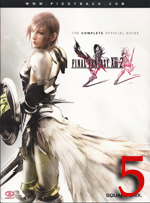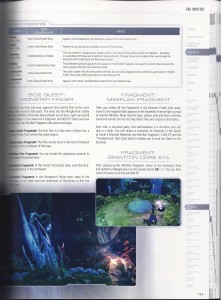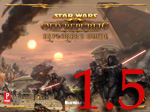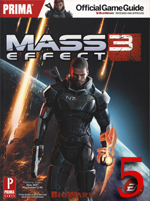 I owe Prima Games such a huge apology for just now sitting down to write this strategy guide review. Maybe if the guide was terrible I wouldn’t feel so badly, but the fact is that it isn’t terrible. It’s far from terrible. I couldn’t imagine a better guide for the end of such an epic story. So let’s delve into exactly why the Mass Effect 3 strategy guide is worthy of its high score.
I owe Prima Games such a huge apology for just now sitting down to write this strategy guide review. Maybe if the guide was terrible I wouldn’t feel so badly, but the fact is that it isn’t terrible. It’s far from terrible. I couldn’t imagine a better guide for the end of such an epic story. So let’s delve into exactly why the Mass Effect 3 strategy guide is worthy of its high score.
The writers obviously had to play the game under at least three different versions of Shepard in order to fully experience all of the differences the game had to offer depending on your import and the decisions you made in the past games:
- Shepard who was imported into 2 from 1;
- Shepard who was imported from 2, but not 1; and
- Fresh Shepard, sans imports.
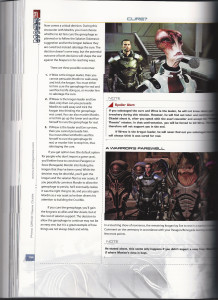 Then when they wrote the book, they wrote it for players with a fresh Shepard. For those who imported a Shepard, the book included little side notes and call-outs to detail the different experiences between the imports. In this way, newcomers won’t feel as left out, and they can see how playing the other games can affect this one, which may get them interested in playing the first two. As for the seasoned veterans like myself, we got to see how different things would have played out between the imports and the decisions. As a personal result, I’m ready to go back into ME2 and make different decisions to see if I can replicate more of the situations I wasn’t able to access.
Then when they wrote the book, they wrote it for players with a fresh Shepard. For those who imported a Shepard, the book included little side notes and call-outs to detail the different experiences between the imports. In this way, newcomers won’t feel as left out, and they can see how playing the other games can affect this one, which may get them interested in playing the first two. As for the seasoned veterans like myself, we got to see how different things would have played out between the imports and the decisions. As a personal result, I’m ready to go back into ME2 and make different decisions to see if I can replicate more of the situations I wasn’t able to access.
The guide’s walkthrough separated all of the side missions from the main walkthrough, so there is some flipping back and forth involved. However, in this instance, it didn’t bother me at all. Many of the major side missions you receive from emails or from talking to other characters on the Normandy, so there is rarely a chance of missing one. When these missions unlock, the main walkthrough always offers suggestions that now is the time to play this side mission or you never will or suggests you finish a particular side mission for the gains that will help you in the next main campaign mission.
In addition, the Citadel has a ton of random missions that Shepard can only unlock by overhearing conversations. So by separating these missions from the main walkthrough, players can plan trips to the Citadel just for unlocking and completing these missions. It also keeps them from cluttering up the main walkthrough. The guide displays after which main campaign missions these side missions unlock, so it becomes a bit of a force of habit that once you finish a story element, you look and see what people in the Citadel are yammering about.
The Mass Effect 3 strategy guide also handled spoilers splendidly. As you can see from the page above, all spoilers are neatly and clearly laid out in call-out boxes, so you can ensure that you will not accidentally read a spoiler. They do something very similar in every situation where you have to make a story-altering choice. The list of possibilities is centered in the page with its own call-out box, and the text is even grayed out a little so that once again, readers won’t accidentally read a spoiler. It’s perfect for making a decision on your own and then going back to see what other outcomes there could of been, how you can determine the outcomes, and what decisions from past games affected your ability to achieve said outcomes.
How they presented the possible outcomes for the ending was downright genius. The list of outcomes had its own page, as you would expect, but the page was printed upside down, as shown to the left. In other words, there was no way you could definitively find out the endings from flipping through the guide. You had to work for them a little.
Since the campaign of Mass Effect 3 was so linear, the campaign walkthrough did not have any maps. If there were any collectibles to pick up, they were mentioned in the walkthrough. However, the multiplayer section does contain maps for all of the pre-DLC regions. This section is my lifeline for the one map I utterly despise: the Nuclear Reactor map. It’s so dark and so winding, and I have a tendency to get stuck in really bad places. And then I die. And my teammates can’t get to me fast enough. So when I see that we’re playing this map, I flip open the guide almost immediately. It’s gotten me out of more sticky situations than I care to admit. (I really, really HATE that map.)
The multiplayer section is also very useful for planning out which races/classes you want to play as. When you start multiplayer, your only options are humans, male and female. I want to play as a turian (should be no shock there), but since I learned from the guide that turians are only sentinels and soldiers, I knew I had to master those roles so I could easily slip into playing as a turian whenever I unlock one.
The only complaint I do have is the lack of a series of galaxy maps. There isn’t any mining of planets this time around (boooo), but you can scan star systems for war assets and items needed for Citadel fetch quests. The guide does explain that the locations of the war assets depends on if you imported Shepard or not and what decisions you made for the past games, so yes, it would have been a massive undertaking. However, having such maps with at least possible markers for items—and surely the fuel pickups are the same, no matter your game—would have been incredibly useful for those, like me, who wanted to 100% every star system. It also would have saved me some time from scanning certain systems that had nothing to offer. Considering I did 100% every star system and I maxed out my possible war assets (not readiness rating), such a map is obviously not required, but it would have been nice.
Mass Effect 3 was a perfect sendoff for the series, and the Mass Effect 3 strategy guide was a perfect follow-up for the sendoff. The writers should be very proud of themselves for taking on this monstrosity of a project and executing it flawlessly.
SGR Rating: 5/5
Authors: Alexander Musa and Fernando Bueno
Publisher: Prima Games
Editions Available: Paperback and Collector’s Edition
Acquired via Publisher
